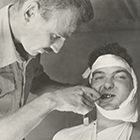Dentists on the front lines
August 26, 2015
With swollen cheeks and a white bandage wrapped around his jaw, Lieutenant D. M. Gordon wears the lopsided grimace of dental patients everywhere. But this Second World War soldier isn’t suffering from an ordinary toothache. Lieutenant Gordon was shot in the jaw by a German sniper while standing in the turret of his tank during the Allied invasion of Sicily in 1943. His photo was snapped at a field hospital in Algeria, where Major D. M. Tanner of the Royal Canadian Dental Corps treated Lieutenant Gordon’s wound.
The black-and-white photo forms part of the Museum’s special exhibition Oral History – A Century of Canadian Military Dentistry. Throughout the exhibition, artifacts and images show how the work of Canada’s military dentists has touched the lives of soldiers and civilians in disaster zones from the First World War to the present.
“The idea behind the exhibition was to do a ‘then’ and ‘now’ of military dentistry,” says curator Dr. John Maker. “With the photo panels and war art in the middle, I wanted to create a bridge between what it looked like when they started in 1915, and what it looks like today.”
In the trenches
A reconstructed First World War field clinic shows the instruments dentists used to treat severe tooth decay and necrotic gum disease amid the unsanitary conditions of the trenches. A folding wood-and-leather dental chair with its own wooden carrying case, and a matching wooden dental chest containing dental moulds, wax, instruments and sterilization equipment, show how dentists travelled to the front lines to treat patients.
Modern disaster relief
Directly opposite, a modern air-transportable dental clinic displays the state-of-the-art equipment that the Canadian Forces deploy today in war zones and disaster areas. These modules — fully equipped with electrical generator, power drill, air syringe, X-ray machine, laptop computer and other tools of the dental trade — have been used in Bosnia-Herzegovina, Haiti, Afghanistan and the Canadian North.
The art of dentistry
Hung between the antique and modern sections, an enlarged print of Second World War artist Bruno Bobak’s painting Dental Treatment No. 2 depicts two dentists in white coats treating a soldier in the back of a truck outfitted as a mobile dental clinic, while the tents of an army encampment stand in the background.
“It’s a painting that’s profound in its mundanity,” says Maker. “It’s a depiction of everyday life, and it gives you an idea of the vast, well-established and complex Canadian soldier society in Britain in the Second World War.”
Though we often take our dentists for granted, in times of war and disaster the dentist’s white coat is a welcome sight, and the clinic — whether in a hut, a truck or an airlifted pod — provides a sanctuary of health amid a sea of destruction.
Oral History – A Century of Canadian Military Dentistry runs until November 1 in the LeBreton Gallery. The exhibition was created by the Canadian War Museum in partnership with the Royal Canadian Dental Corps to mark their first 100 years.
Top: In 1943, Lieutenant D.M. Gordon was shot by a sniper as he stood in the turret of his tank in a village in Sicily. Gordon was evacuated to a dental company at a base in Algeria, where he was treated by Major D.M. Tanner of the Royal Canadian Dental Corps. Photo : Courtesy of the Directorate of History and Heritage, National Defence
Bottom: In the absence of electricity, dentists relied on foot-powered drills during the First World War. Procedures done with foot-powered drills were longer and more painful because the drill turns more slowly than electric ones. Loan from the Museum of Health Care at Kingston, Ontario, Crawford Collection, 010.020.064 a-f
